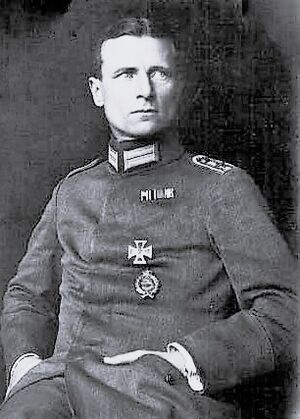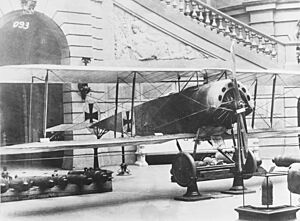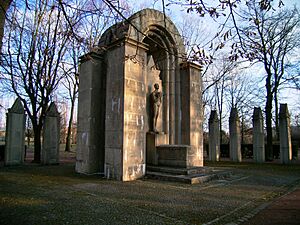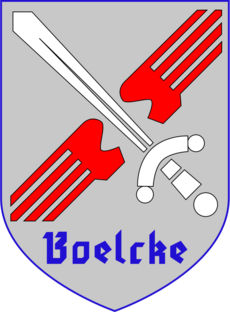Oswald Boelcke facts for kids
Quick facts for kids
Oswald Boelcke
|
|
|---|---|

Oswald Boelcke wearing his Pour le Mérite
|
|
| Born | 19 May 1891 Giebichenstein, Province of Saxony, Prussia; near Halle (Saale) |
| Died | 28 October 1916 (aged 25) near Bapaume, France |
| Allegiance | German Empire |
| Service/ |
Telegraphen-Bataillon Nr. 3 (Telegraph Battalion No. 3); Luftstreitkräfte (Air Force) |
| Years of service | 1911–1916 |
| Rank | Hauptmann (Captain) |
| Unit | Feldflieger Abteilung 13 (Field Flyer Detachment 13) |
| Commands held | Jagdstaffel 2 (Fighter Squadron 2) |
| Awards | Pour le Mérite, Royal House Order of Hohenzollern, Knight's Cross with Swords, Iron Cross, First and Second Class, Lifesaving Medal, Plus eight lesser decorations |
Oswald Boelcke (born May 19, 1891 – died October 28, 1916) was a German soldier and a very important flying ace during World War I. He was known for shooting down 40 enemy airplanes. Many people call Boelcke the "father" of the German fighter air force. He also created many of the rules for air combat that are still used today.
Boelcke was a great leader and teacher for other pilots in the early days of air fighting (1915 and 1916). He joined the Imperial German Army in 1911, fulfilling his childhood dream. When World War I began, he quickly learned to fly.
After working as an aerial observer in 1914, he became one of the first fighter pilots in mid-1915. He flew the first real fighter planes, called Fokker Eindeckers. Boelcke, Max Immelmann, and other early aces started shooting down enemy planes. Boelcke and Immelmann were the first German pilots to receive Germany's highest award, the Pour le Mérite.
After his 19th victory, Boelcke was told to stop flying for a while. During this time, he helped turn the German air force into the powerful Luftstreitkräfte. He also wrote down his combat experiences in the first-ever guide for fighter pilots, called the Dicta Boelcke. This guide shared rules for pilots to succeed and for teams to work together. Modern fighter tactics still come from his ideas.
Later, Boelcke was chosen to lead one of Germany's first fighter squadrons, Jagdstaffel 2 (Fighter Squadron 2). He carefully picked his pilots and taught them his Dicta rules. In September and October 1916, Boelcke won 21 more victories. This made him the world's top-scoring ace. Sadly, he died on October 28, 1916, in a mid-air crash with his friend, Erwin Böhme.
By the end of the war, his squadron (renamed Jasta Boelcke) had 25 aces. Many of them went on to lead other squadrons. Boelcke's influence is still felt today. There are many tributes to him at the German Air Force's Nörvenich Air Base and across Germany.
Contents
Early Life and Military Dreams
Oswald Boelcke was born on May 19, 1891, in Giebichenstein, a town near Halle (Saale) in Prussia. His family had moved back to Germany from Argentina before he was born.
When he was four, his family moved to Dessau. He saw planes flying overhead near the Junkers factory. This was his first look at aircraft. Even though he had asthma, Boelcke loved sports. He was good at soccer, tennis, skating, and gymnastics. He was also a great swimmer and diver.
Boelcke was a good student, especially in math and physics. His family wanted him to have a military career. When he was ten, he wrote a letter to Kaiser Wilhelm asking to join military school. He was accepted at 13, but his parents decided against it. He finished high school instead.
His interest in the military continued. He read books about military history and airships. On February 11, 1911, he graduated with honors.
Joining the Military
After school, Boelcke joined a telegraph battalion in Koblenz on March 15, 1911. He saw more airplanes there. In January 1912, he went to the Military Academy in Metz. He spent his free time watching planes at a nearby airfield.
In July 1912, he graduated and became an ensign. Because he had finished high school, his rank was back-dated. This made him senior to others in his battalion. He was soon promoted to lieutenant.
In 1913, Boelcke got to fly in some planes while in Metz. He also saw a famous French pilot, Adolphe Pégoud, perform amazing aerobatics. In February 1914, Boelcke placed third in an officer's competition. This qualified him for the 1916 Olympics in Berlin.
World War I Begins
Without telling his family, Boelcke asked to join the air force. On May 29, 1914, he was accepted for pilot training. He started a six-week course on June 2. He passed his final pilot exam on August 15. His first job was training new pilots.
World War I had already started, and Boelcke wanted to fight. On August 31, he managed to join his older brother Wilhelm at Feldflieger Abteilung 13 (Field Flyer Detachment 13). They flew their first mission together on September 1. They flew many missions, often more than anyone else in their unit. By the end of 1914, Oswald had flown 42 missions behind enemy lines.
New Fighter Planes
In early 1915, there wasn't much fighting on the ground. Boelcke had to go to the hospital for his asthma. In April, he and his brother were separated. Oswald was sent to Feldflieger Abteilung 62 (Field Flyer Detachment 62) in France.
He soon joined Kampfeinsitzerkommando Douai (Combat Single-Seater Command Douai) on May 19. He was the most experienced pilot there. This is where he became friends with Max Immelmann. Both Boelcke and Immelmann would fly the unit's new Fokker Eindeckers. These planes started what was known as the "Fokker Scourge."
The First Fighter Planes
Early in the war, French pilots like Roland Garros and Adolphe Pégoud were the first to shoot down enemy planes. They became heroes. German newspapers also started celebrating their own pilots.
Boelcke got his first confirmed victory on July 4, 1915, in a two-seater plane. After this, he switched to the new Fokker Eindecker. This plane was special because it had a machine gun that fired through the propeller. A special device, called a synchronization gear, stopped the bullets from hitting the propeller blades. This made it much easier to aim. You just aimed the plane at the enemy!
The German military initially used these new planes for defense. They didn't want to risk them over enemy lines. But Boelcke and other Fokker pilots soon ignored this rule and flew aggressively.
The "Ace Race" Begins
In July 1915, Boelcke, Immelmann, and others began flying the Eindecker in combat. There were no rules for air combat yet. Boelcke would later write the first guide.
On July 1, another pilot, Wintgens, got the first victory with a Fokker, but it wasn't confirmed until after the war. Boelcke's first victory in a Fokker was on August 19, 1915. He forced a British plane down. By then, pilots like Wintgens, Boelcke, and Immelmann were becoming famous.
Boelcke and Immelmann often flew together. By September 1915, better Eindeckers were arriving. On November 1, after his sixth victory, Boelcke received the Royal House Order of Hohenzollern. Immelmann got the same award six days later. The British and French began to call the deadly effect of these new planes the "Fokker Scourge."
By the end of 1915, Immelmann had seven victories, and Boelcke had six.
1916: A Year of Victories and Changes
On January 5, 1916, Boelcke shot down a British plane. He landed nearby and found the pilot spoke German. Boelcke even visited him in the hospital. This incident was front-page news because Boelcke was so famous.
On January 12, Boelcke and Immelmann each shot down their eighth victims. They were immediately given the Pour le Merite, Germany's highest award. Boelcke became internationally famous. Generals and nobles wanted to meet him.
Boelcke was later put in charge of a new unit called Fliegerabteilung Sivry (Flying Detachment Sivry). This unit of six fighter pilots was the first step towards German fighter squadrons. Boelcke set up the first air traffic control center. He also became friends with Prussian Crown Prince Wilhelm.
On March 12, Boelcke became the first pilot to reach 10 victories. The next day, Immelmann tied him with 11 victories. The old Fokker E.III planes were being replaced by newer, better fighters like the Halberstadt D.II and Albatros D.I. These new planes had two synchronized machine guns. Boelcke focused on developing new fighter tactics, like flying in groups and shooting accurately.
The "ace race" continued between Boelcke and Immelmann. On May 21, 1916, Boelcke shot down two more planes. The emperor promoted him to Captain, making him the youngest captain in the German military at 25.
The End of the Ace Race
Immelmann was killed on June 18, 1916, after his 17th victory. Boelcke, with 18 victories, was now the top ace. After Immelmann's funeral, Kaiser Wilhelm II ordered Boelcke to stop flying for a month. He was too important to risk losing. Boelcke scored his 19th victory before reporting to headquarters on June 27.
There, he helped reorganize the German air service into the Luftstreitkräfte (Air Force). Boelcke wrote down his successful tactics in the Dicta Boelcke. These eight rules were the first training manual for fighter pilots. They taught pilots how to gain an advantage in combat and how to work as a team.
Building a Squadron
On July 10, 1916, Boelcke went on a trip to the Balkans and the Ottoman Empire. He visited military bases and met important people. While he was away, the French and British air forces gained control of the skies on the Western Front.
Boelcke was called back quickly. He was told to create and lead a new fighter squadron, Jagdstaffel 2 (Fighter Squadron 2). He was given permission to choose his own pilots.

Boelcke recruited pilots, including a young cavalry officer named Manfred von Richthofen (who later became "The Red Baron"). He also chose Erwin Böhme, a 37-year-old engineer. Boelcke returned to France to set up his squadron.
His squadron started with empty buildings. They needed 14 planes, pilots, and ground crew. By September 8, they had eight pilots, including Richthofen and Böhme. While the squadron was getting ready, Boelcke flew solo missions. On September 2, he got his 20th victory.
Boelcke trained his pilots carefully. They learned about machine guns and how to recognize enemy planes. He taught them his tactics, like flying in pairs and attacking together. He told them, "I only open fire when I can see the goggle strap on my opponent's crash helmet."
Into Battle with Jagdstaffel 2
New, powerful Albatros D.II and Albatros D.I fighters arrived on September 16. These planes were faster and had two machine guns. With these new aircraft, Jagdstaffel 2 flew its first squadron missions on September 17. Boelcke got his 27th victory, and his pilots shot down four more.
Boelcke continued to train his pilots. He discussed missions before flights and listened to his pilots' ideas. He also debriefed them after each flight.
By October 1, Boelcke had 30 victories. The squadron was doing very well. On October 8, the German air force was officially reorganized into the Luftstreitkräfte. The Dicta Boelcke was then shared with all pilots.
On October 10, Jagdstaffel 2 flew 31 missions and claimed five victories, including Boelcke's 33rd. He achieved 11 victories in October, reaching his 40th on October 26. This made him the top ace of the war. Jagdstaffel 2 had 50 victories by this time.
Boelcke's Last Mission
On the evening of October 27, Boelcke was tired and sad. He went to his room early. His friend Böhme joined him, and they talked for a long time. The next day, October 28, was misty. The squadron still flew several missions.
On the sixth mission, Boelcke and five pilots attacked two British planes. Boelcke and Böhme chased one plane, while Richthofen chased the other. As the planes moved, Boelcke's upper left wing lightly touched the underside of Böhme's plane. The fabric on Boelcke's wing tore, and his plane lost control. It spiraled down and crashed near a German artillery battery.
Boelcke was not wearing his helmet, and his seatbelt was not fastened. He died from a fractured skull. Böhme landed safely but was very upset. An investigation found that it was an accident.
Remembering a Hero
Pilots from Jagdstaffel 2 rushed to the crash site. They found Boelcke's body. His memorial service was held in the Cambrai Cathedral on October 31. Many wreaths were sent, including one from British prisoners that said, "To the memory of Captain Boelcke, our brave and chivalrous opponent."
Rupprecht, Crown Prince of Bavaria attended the service. Richthofen carried Boelcke's awards in front of the coffin. Airplanes flew overhead as a tribute. Boelcke's body was taken by train to Dessau.
On November 2, his funeral was held. Many important people, including royalty and generals, attended. Boelcke was buried in the Cemetery of Honor in Dessau.
Boelcke's Lasting Impact
Boelcke was a kind and polite person. He was a pioneer in air-to-air combat. He created the first fighter squadron organization and early-warning systems. He is truly called "the father of air combat."
His success inspired other pilots and the German public. Because of him, the German Air Service started its Fighter School to teach his tactics. The Dicta Boelcke became the main guide for German fighter pilots. Grouping fighter planes into squadrons helped Germany gain control of the skies.
Jagdstaffel 2 was renamed Jagdstaffel Boelcke after his death. It remained one of Germany's best fighter squadrons. It achieved 336 victories during the war.
Many of the pilots Boelcke chose became aces. Three of them later commanded the squadron. By the end of the war, 25 aces had served in his squadron. Four of his aces became generals in World War II. The Red Baron himself said that Boelcke greatly influenced him.
Boelcke's name is still honored today. The coat of arms of a modern German Air Force fighter wing, Taktisches Luftwaffengeschwader 31, carries his name. This wing visits his grave every year on the anniversary of his death. He is also remembered at the Norvenich Air Base with murals, portraits, and a bust.
Awards and Honors
German Awards
- Pour le Mérite (Germany's highest military honor)
- Royal House Order of Hohenzollern, Knight's Cross with Swords
- Iron Cross: First and Second Class
- Lifesaving Medal
Other German Awards
- House Order of Albert the Bear, Knight's Cross, 1st and 2nd class
- Friedrich Cross, 2nd class
- Military Merit Order, 4th class with Swords
- Saxe-Ernestine House Order
- Knight of the Military Merit Order
Foreign Awards
- Imtiyaz Medal (Ottoman Empire)
- Order of the Iron Crown, 3rd class with war decoration (Austro-Hungary)
- Order of Bravery, 3rd class (Bulgaria)
Honors
- By order of the Emperor, Jagdstaffel 2 was renamed as Jagdstaffel Boelcke on December 17, 1916.
See also
 In Spanish: Oswald Boelcke para niños
In Spanish: Oswald Boelcke para niños





